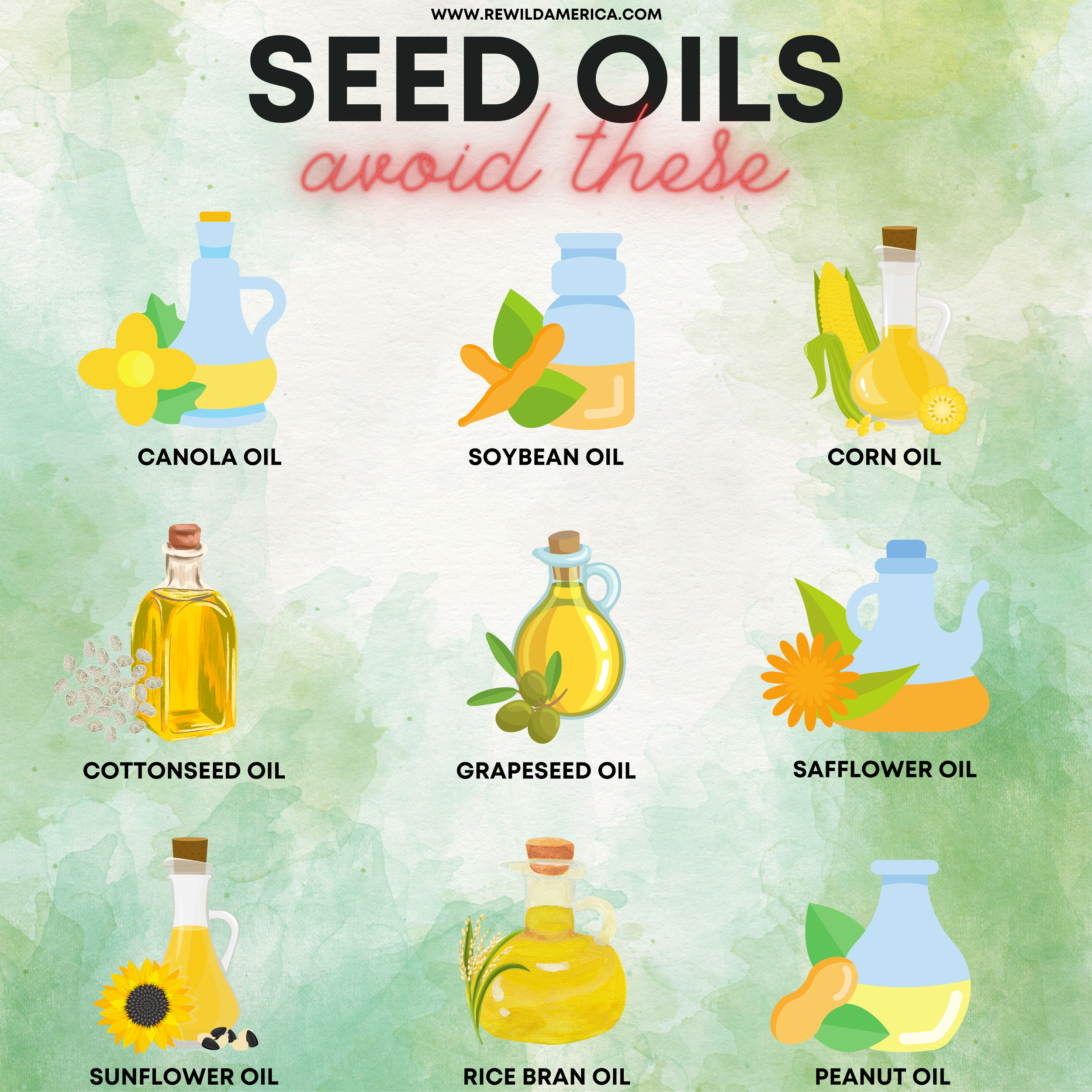Seed Oils Exposed: Why You Should Avoid Them and Healthier Alternatives
Left: healthy fats-nourishing alternatives for a healthier you. Right: seed oils—cheap and plentiful but linked to inflammation and chronic diseases.
Introduction
In past posts, we've touched on the topic of seed oils, cautioning against their consumption. We realize we've yet to delve into the reasons that fuel our strong stance on this issue.
In this post, we will unpack the evidence that has led us to advise against incorporating seed oils into your diet. Additionally, we'll present health-conscious alternatives that allow you to savor your culinary experiences without compromising your well-being.
If you're contemplating a single dietary change, begin with removing foods made with these oils.
What Are Seed Oils?
Seed oils are edible oils extracted from the seeds of various plants. These oils are commonly used for cooking, frying, and as ingredients in a wide range of processed foods. Some of the most prevalent seed oils include canola oil, soybean oil, corn oil, sunflower oil, and safflower oil. These oils are often known for their long shelf life and high smoke points, making them seemingly ideal for a variety of cooking applications.
However, it's important to differentiate between seed oils and oils obtained from fruits, such as olive oil and avocado oil. Unlike these latter categories, seed oils are generally high in polyunsaturated fatty acids (PUFAs), particularly omega-6 fatty acids.
The extraction process for most seed oils often involves high heat, solvents, and mechanical pressing, which can degrade the oil quality and lead to the formation of harmful compounds. Moreover, the high omega-6 to omega-3 ratio found in many seed oils has been a point of concern among health pioneers, as it's thought to promote inflammation and contribute to a variety of chronic diseases.
The oft-repeated mantra that "fat is fat" and directly leads to heart disease and obesity oversimplifies the complex roles that different types of fats play in human physiology. Rest assured, we will delve deeply into this topic in a future post.
For a detailed video on the evolution of seed oils, watch The 100 Billion Dollar Ingredient Making Your Food Toxic. A surge in production has not only fueled profit growth but has also been linked to a rise in health concerns.
The Evolution of Seed Oils
The saga of seed oils begins with an ingenious bit of recycling in 1829. Until that point, the seeds of the cotton plant were discarded as waste. Yet innovators soon found a way to extract oil from these neglected seeds, thereby transforming a previously useless byproduct into a marketable commodity. Initially, cottonseed oil fueled lamps and lubricated machinery—mundane yet essential roles in a flourishing industrial society.
The practice of repurposing plant waste soon extended to corn. By the early 1880s, oil was being extracted from corn germ, and by the late 1890s, corn oil had already found its way into commercial kitchens.
A pivotal moment arrived in 1911 when Procter & Gamble, originally a soap and candle manufacturer, developed a method to crystallize cottonseed oil. The result resembled lard and offered a more cost-effective and readily available alternative to animal fats, which had long dominated both industrial and culinary applications. Enter Crisco, a product that swiftly permeated American households and became an indispensable kitchen staple.
In essence, seed oils have metamorphosed from discarded waste to a ubiquitous cooking ingredient. This transformation has come with caveats. Following the mass production of seed oils came a surge in heart disease and obesity. Intriguingly, the American Heart Association (AHA) was founded around this time, and not long after receiving generous donations from Crisco, began endorsing the product as a “healthier alternative” to animal fats.
To distill it down for the moment: seed oils are calorically dense but nutrient-poor. Predominantly consisting of polyunsaturated fats—specifically omega-6 fatty acids, or linoleic acid. This composition is linked to inflammation, a root cause of a myriad of health conditions ranging from allergies to chronic illnesses, extending far beyond just heart disease and obesity.
Initial steps to propel you on your journey to vitality.
Alternatives to Seed Oils
You may find yourself in a culinary conundrum, asking, "If seed oils are so pervasive and potentially problematic, what on Earth should I be eating?" Rest assured, viable alternatives exist, although they may require you to become more hands-on in your kitchen.
The Roadmap to Eliminating Seed Oils:
Minimize Dining Out: The first step is to curtail your consumption of fast foods and restaurant fare, which are often laden with seed oils.
Ingredient Swap: Replace the seed oils lurking in your pantry with the following nutrient-dense alternatives:
Organic Extra Virgin Olive Oil: Ideal for use in its raw form, such as salad dressings or drizzles.
Raw, Unpasteurized, 100% Grass-Fed Butter: Perfect for low-temperature cooking.
Organic Avocado Oil: Excellent for high-heat cooking.
Organic Extra Virgin Coconut Oil
Organic 100% Grass-Fed Tallow (Beef Fat): Good for high-heat cooking.
100% Grass-Fed Ghee: A clarified butter that's suitable for those who are lactose intolerant. Good for high-heat cooking, frying and deep-frying.
Primal Kitchen Dressings/Sauces: Opt for brands that explicitly exclude seed oils.
A Note on Smoke Points: It's crucial to acquaint yourself with the smoke points of these cooking mediums. The smoke point is the temperature at which the oil or fat begins to break down and burn, compromising not only its nutritional profile but also that of the food you're cooking.
If you're on the go frequently and worry about preparing food, check out previous blog posts for tips on how to eat healthy while traveling:
Conclusion
The surest way to dodge the presence of seed oils is to opt for foods that come without a label—those that remain as nature intended.
Embarking on this journey won't come with an "easy" button, but taking control of your food choices empowers you to prioritize your health. And remember, becoming the master of your kitchen is not just about avoiding seed oils; it's about embracing a lifestyle that aligns with optimum well-being.
Enrich your pantry with a vibrant array of organic fruits and vegetables, and grass-fed meats. Along with minimally processed foods that feature an ingredient list devoid of unnecessary additives. Transition away from seed oils by embracing "fruit oils" like olive and avocado oil, and high-quality animal fats such as grass-fed tallow or ghee. Make it a mission to source cooking ingredients that conscientiously exclude seed oils.
By adopting this approach, you're not just avoiding potential pitfalls; you're making a committed stride towards holistic well-being, one meal at a time.
References





